A dwindling craft
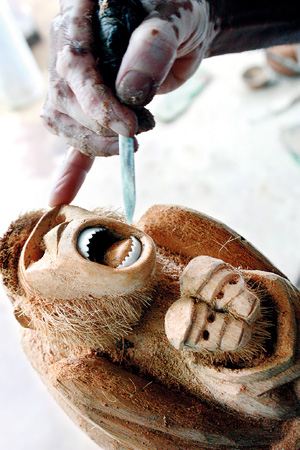
Painstaking work: The carving in progress. Pix by Athula Devapriya
These are familiar souvenirs so representative of this land of swaying palm trees; the coconut crafts. Novel creations made of coconut shell, human and animal figures, they sit pretty on the shelves of handicraft shops. Yet the quantum of effort needed to create them, is something that escapes our attention.
In the village of Ihala Kosgama, close to Avissawella, coconut carving has been a cottage industry practised for many decades ever since a well-known koraley mahattaya (village headman) I.P. John first introduced it to the village, inspiring many youngsters to follow in his footsteps.
Yet the industry that has been a lifeline for the villagers for close to 50 years is dwindling now with only about 20 families, still engaged in this trade. Their work is still distinctive, the carved faces immediately recognisable: the gama haminey, mudliyar, or even those in the political scene, masks, animal figures of monkeys, tortoises, and elephants and other souvenirs like birds’ nests, key tags and tea containers.
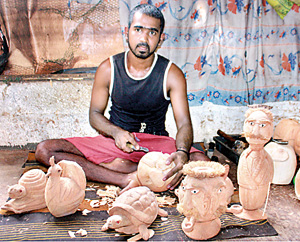
Danushka at work: A variety of creations
A few hours in the village on a bright Wednesday morning gave the Sunday Times team an insight into how this cottage industry is carried out. Unfinished products are kept for drying, along the narrow, gravel footpaths in the village and most village households have small workshops in their home garden.
For the women, the industry brings in some extra cash to meet their household expenses, says M. D. Malkanthi who has been engaged in this line of work for the past 10 years after she moved into the village with her husband. “I am able to earn about Rs 10,000 a month. I use the money for my children’s education- to buy them school books or pay their tuition fees,” says Malkanthi showing us the animal figures she has carved. “There are times when we do not get orders,” she says adding that finding a market for their products is their biggest challenge.
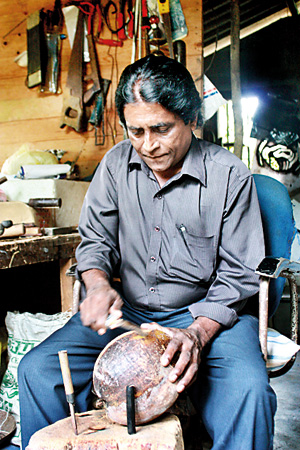 Wijeydasa Singakkara has mastered the art over the past 30 years. Of the beautiful carvings inside his workshop, he shows us one he is particularly proud of – a portrait of former President J.R. Jayawardene and recalls the days when I.P John, the master craftsman who introduced the trade to the village, groomed him.
Wijeydasa Singakkara has mastered the art over the past 30 years. Of the beautiful carvings inside his workshop, he shows us one he is particularly proud of – a portrait of former President J.R. Jayawardene and recalls the days when I.P John, the master craftsman who introduced the trade to the village, groomed him.
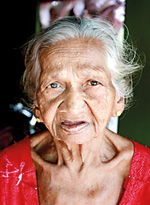
Mary Nona
So how is it done? He peels the raw coconut, makes a quick sketch on it before he starts carving it. It has to be dried in the hot sun for a few days to take the moisture out, he explains adding that this is vital to ensure that fungus does not grow on the products. Finally, they polish the items, but the demand now is for the rough finish, especially among foreign buyers, he says.
Then comes the hard part – marketing their products. They target the souvenir shops in the tourist hot spots as they do not have fixed buyers- a huge issue confronting these small scale manufacturers. “There are two or three people from the village who work as middlemen who take our products to various shops as well,” Malkanthi adds. Reaching out to foreign buyers is necessary as what they earn from the local market selling at trade fairs, or supplying to sales outlets or small souvenir shops is not sufficient, the craftsmen say.
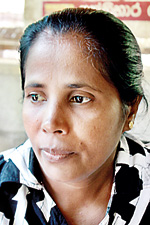
Malkanthi
“We have a few mobile vendors in the village. But sometimes business is not profitable when third parties are involved as we do not get the real value for all the hard work we put in. We know how expensive these items are in the shops outside. They sell our products keeping a huge margin,” they lamented adding that getting payments from certain handcraft shops is also difficult sometimes.
Forming a co-operative society a few years ago, they were able to appeal for government assistance to construct workshops and get their tool kits. Danushka Sanjeewa is one of the young craftsmen who works around the clock meeting a target of producing 300-350 items per month. He specialises in animal figures which he manufactures for tea export companies. “These can be used as tea containers,” he shows us a product in the making.
Different figures require coconuts of different shapes – for the elephant or human faces rounder nuts are needed while for monkeys, the nuts should be oval-shaped, he says. Danushka is content with the freedom that this job gives him. “If we are able to find a market and get a decent rate for our products, there is nothing to complain about for doing something like this is very satisfactory,” Danushka adds.
 Mary Nona, the wife of I.P John, is 92 now, feeble and bedridden. Her husband is too weak to speak. She can still recall how he used to create beautiful coconut carvings and sell them by the ambalama in the junction or near the Avissawella Rest House. “My two sons and I used to assist him to polish the products. People in the village too came to see him at work and later they learnt the techniques. He stopped doing this 10 years ago after he fell from a tree and broke his leg. Thereafter my sons continued the trade.”
Mary Nona, the wife of I.P John, is 92 now, feeble and bedridden. Her husband is too weak to speak. She can still recall how he used to create beautiful coconut carvings and sell them by the ambalama in the junction or near the Avissawella Rest House. “My two sons and I used to assist him to polish the products. People in the village too came to see him at work and later they learnt the techniques. He stopped doing this 10 years ago after he fell from a tree and broke his leg. Thereafter my sons continued the trade.”
John’s son I.P. Jayaratne says business was flourishing for him a few years ago when he had a standard order from a Lankan living in the Maldives, and the money earned, he invested buying the land he lives on today. “I was only 15 years old when I first started doing this. In the 1970s I remember my first sale to a Muslim lady near the thambili stall in the village. I asked for three rupees but the lady gave me three rupees and 50 cents. I was so thrilled that it made me want to make more,” says Jayaratne.
Finding a stable market, storage and getting rid of the moisture are some other challenges facing the craftsmen, especially during the rainy season. “After manufacturing the goods, if we have storage facilities to keep the products under a hot temperature for a few weeks, that would be helpful, especially during the rainy season,” says Ajith Wijeysinghe who talks of a special burner saying that he lacks the technological know-how to build one.
Ihala Kosgama has produced a line of skilled craftsmen with a knack for creating decorative coconut carvings, but they desperately need a helping hand to sustain their trade.
| Assisting these dedicated craftsmen How does the state assist these dedicated craftsmen? The Assistant Commissioner of the Western Province National Crafts Council Sunanda Bandara under whose purview the Ihala Kosgama village falls, said the Crafts Council facilitates their participation at provincial handicraft programmes opening up opportunities to take part in the national level exhibitions.The National Crafts Council has helped them find provincial markets by arranging stalls at provincial trade exhibitions and opening small sales outlets at various locations. “Our main objective is to empower the craftsmen and help them sustain the industry by getting them organised. We conduct workshops and training for them, in addition to facilitating their participation at foreign exhibitions,” he said. Laksala Chairman Hasitha Tillekeratne said the supply from the manufacturers from the village has been considerably low, probably due to the capacity issues they face. Asked about the concerns regarding payment delays, the Chairman said that for small time manufacturers, payments are settled immediately. It is important that they supply quality products, he added. | |


